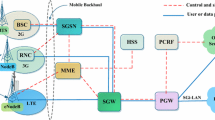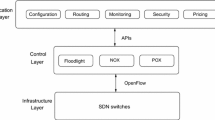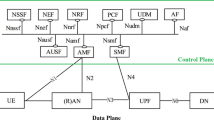Abstract
Mobile Internet traffic is expected to grow faster than the fixed Internet traffic in a near future. Since, today’s broadband networks are approaching theoretical limits in terms of spectral efficiency per link, mobile operators are compelled to seek for new solutions that will be able to accommodate the expected traffic growth and improve their position in the competitive market. Addressing those challenges with current inflexible, not scalable and complex architecture is very hard, if possible at all. Software defined networking (SDN) is a new networking architecture paradigm that holds great promise to overcome many of mentioned limitations and provides required improvements in performance by decoupling control functions from underlying physical infrastructure. In this paper, we explain key reasons for transition to SDN based mobile networks and briefly describe several proposals of design scenario. Special emphasis is placed on SDN’s contribution to more efficient inter-cell interference management, traffic control and network virtualization.






Similar content being viewed by others
References
Shafiq, M. Z., Ji, L., Liu, A. X., Pang, J., & Wang, J. (2012). A first look at cellular machine-to-machine traffic: Large scale measurement and charecterization. ACM Sigmetrics, 40(1), 65–76.
Cisco. (2013). Cisco visual networking index forecast projects 13-fold growth in global mobile internet data traffic from 2012 to 2017. http://newsroom.cisco.com/release/1135354. Accessed 22 February 2013.
Gudipati, A., Perry, D., Li, L. E., & Katti, S. (2013). SoftRAN: Software dened radio access network. In ACM SIGCOMM HotSDN workshop (pp. 25–30).
McKeown, N., Anderson, T., Balakrishnan, H., Parulkar, G., Peterson, L., Rexford, J., et al. (2008). OpenFlow: Enabling innovations in campus networks. ACM SIGCOMM Computer Communication Review (CCR), 38(2), 69–74.
3GPP. (2008). Description document of LTE Release 8. http://www.3gpp.org/specifications/releases/72-release-8. Accessed 22 February 2013.
Li, L.E., Mao, Z. M., & Rexford, J. (2012). Toward software-defined cellular networks. In European workshop on software defined networking (EWSDN) (pp. 7–12).
Jin, X., Li, L. E., Vanbever, L., & Rexford, J. (2013). Softcell: Scalable and exible cellular core network architecture. In ACM conference on emerging networking experiments and technologies (CoNEXT) (pp. 163–174).
Pentikousis, K., Wang, Y., & Hu, W. (2013). MobileFlow: Towards software-defined mobile networks. IEEE Communications magazine, 51(7), 44–53.
Bansal, M., Mehlman, J., Katti, S., & Levis, P. (2012). OpenRadio: A programmable wireless dataplane. In Hot topics in software defined networks (HTSDN) (pp. 109–114).
Ulversoy, T. (2010). Software dened radio: Challenges and opportunities. IEEE Communications Surveys & Tutorials, 12(4), 531550.
Open Networking Foundation. (2013). OpenFlow-enabled mobile and wireless networks. ONF solution brief. https://www.opennetworking.org/images/stories/downloads/sdn-resources/solution-briefs/sb-wireless-mobile. Accessed on 22 February 2013.
Yap, K.-K., Sherwood, R., Kobayashi, M., Huang, T.-Y., Chan, M., N. Handigol, N., et al. (2010). Blueprint for introducing innovation into wireless mobile networks. In ACM SIGCOMM workshop on virtualized infrastructure systems and architectures (VISA10) (pp. 25–32).
Sherwood, R., Gibb, G., Yap, K. K., Appenzeller, G., Casado, M., McKeown, N., et al. (2010). Can the production network be a testbed? In USENIX conference on Operating systems design and implementation (OSDI) (pp. 1–6).
Informa Telecoms & Media. (2013). Mobile SDN: The future is virtual. White paper. http://forums.juniper.net/jnet/attachments/jnet/IndustrySolutionsEMEA/258/1/Mobile-SDN-The-future-is-virtual-final%20July. Accessed on 22 February 2013.
C. M. R. Institute. (2011). C-RAN: The road towards green RAN. http://labs.chinamobile.com/cran. Accessed 22 February 2013.
Chaudet, C., & Haddad, Y. (2013). Wireless software defined networks: Challenges and opportunities. In The international IEEE Conference on microwaves, communications, antennas and electronic systems (COMCAS) (pp. 1–5).
Qadir, J., Ahmed, N., & Ahad, N. (2013). Building programmable wireless networks: An architectural survey. CoRR abs/1310.0251.
Acknowledgments
The work presented in this paper has been performed within the activities of the EU FP7 For e-Mont project
Author information
Authors and Affiliations
Corresponding author
Rights and permissions
About this article
Cite this article
Tomovic, S., Pejanovic-Djurisic, M. & Radusinovic, I. SDN Based Mobile Networks: Concepts and Benefits. Wireless Pers Commun 78, 1629–1644 (2014). https://doi.org/10.1007/s11277-014-1909-6
Published:
Issue Date:
DOI: https://doi.org/10.1007/s11277-014-1909-6




